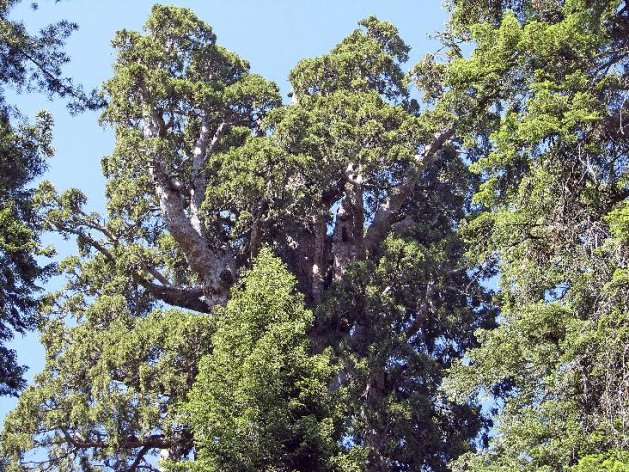
Deep in the Sierra Nevada, the famous General Grant giant
sequoia tree is suffering its loss of stature in silence. What once was
the world's No. 2 biggest tree has been supplanted thanks to the most
comprehensive measurements taken of the largest living things on Earth.
The
new No. 2 is The President, a 54,000-cubic-foot gargantuan not far from
the Grant in Sequoia National Park. After 3,240 years, the giant sequoia
still is growing wider at a consistent rate, which may be what most
surprised the scientists examining how the sequoias and coastal redwoods
will be affected by climate change and whether these trees have a role
to play in combatting it.
"I consider it to be the greatest tree in all of the mountains of the world," said Stephen Sillett,
a redwood researcher whose team from Humboldt State University is
seeking to mathematically assess the potential of California's iconic
trees to absorb planet-warming carbon dioxide.
The
researchers are a part of the 10-year Redwoods and Climate Change
Initiative funded by the Save the Redwoods League in San Francisco. The
measurements of The President, reported in the current National Geographic, dispelled the previous notion that the big trees grow more slowly in old age.
It
means, the experts say, the amount of carbon dioxide they absorb during
photosynthesis continues to increase over their lifetimes.
In
addition to painstaking measurements of every branch and twig, the team
took 15 half-centimeter-wide core samples of The President to determine
its growth rate, which they learned was stunted in the abnormally cold
year of 1580 when temperatures in the Sierra hovered near freezing even
in the summer and the trees remained dormant.
But that was an
anomaly, Sillett said. The President adds about one cubic meter of wood a
year during its short six-month growing season, making it one of the
fastest-growing trees in the world. Its 2 billion leaves are thought to
be the most of any tree on the planet, which would also make it one of
the most efficient at transforming carbon dioxide into nourishing sugars
during photosynthesis.
"We're not going to save the world with
any one strategy, but part of the value of these great trees is this
contribution and we're trying to get a handle on the math behind that,"
Sillett said.
After the equivalent of 32 working days dangling
from ropes in The President, Sillett's team is closer to having a
mathematical equation to determine its carbon conversion potential, as
it has done with some less famous coastal redwoods. The team has
analyzed a representative sample that can be used to model the capacity
of the state's signature trees.
More immediately, however, the new measurements could lead to a changing of the guard in the land of giant sequoias.
The park would have to update signs and brochures — and someone is
going to have to correct the Wikipedia entry for "List of largest giant
sequoias," which still has The President at No. 3.
Now
at 93 feet in diameter and with 45,000 cubic feet of trunk volume and
another 9,000 cubic feet in its branches, the tree named for President Warren G. Harding
is about 15 percent larger than Grant, also known as America's
Christmas Tree. Sliced into one-foot by one-foot cubes, The President
would cover a football field.
Giant sequoias grow so big and for
so long because their wood is resistant to the pests and disease that
dwarf the lifespan of other trees, and their thick bark makes them
impervious to fast-moving fire.
It's that resiliency that makes
sequoias and their taller coastal redwood cousin worthy of intensive
protections — and even candidates for cultivation to pull carbon from an
increasingly warming atmosphere, Sillett said. Unlike white firs, which
easily die and decay to send decomposing carbon back into the air,
rot-resistant redwoods stay solid for hundreds of years after they fall.
Though
sequoias are native to California, early settlers traveled with
seedlings back to the British Isles and New Zealand, where a 15-foot
diameter sequoia that is the world's biggest planted tree took root in
1850. Part of Sillett's studies involves modeling the potential growth
rate of cultivated sequoia forests to determine over time how much
carbon sequestering might increase.
All of that led him to a spot
7,000 feet high in the Sierra and to The President, which he calls "the
ultimate example of a giant sequoia." Compared to the other giants whose
silhouettes are bedraggled by lightning strikes, The President's crown
is large with burly branches that are themselves as large as tree
trunks.
The world's biggest tree is still the nearby General
Sherman with about 2,000 cubic feet more volume than the President, but
to Sillett it's not a contest.
"They're all superlative in their own way," Sillett said.











 This unusual knife/pistol combination has a flintlock pistol as the
handle for the knife and the knife the grip area for the pistol. The
knife blade is 5 3/4 inch in length with a curved tip (similar to a
butter knife) and decorative ricasso with floral scroll engraving. The
handle/pistol portion is silver plated with floral scroll engraving. The
top has a banner marked "F.X. RICHTER" and the bottom "IN REICHEBERG".
The muzzle is coming out of a dragon/serpents mouth. There is a hammer,
pan, frizzen and single spring mounted on the right side and the
trigger, two springs and a locking mechanism between the hammer and
forward spring are mounted on the left side. When the hammer is cocked,
the mechanism rotates and the hammer catches a notch and holds the
hammer. Pulling the trigger, releases the hammer and the pistol is
fired. Due to the fact that the knife is the grip for the pistol, writer
assumes there would normally be a scabbard of some sort otherwise
firing the pistol could be a little hazardous.
This unusual knife/pistol combination has a flintlock pistol as the
handle for the knife and the knife the grip area for the pistol. The
knife blade is 5 3/4 inch in length with a curved tip (similar to a
butter knife) and decorative ricasso with floral scroll engraving. The
handle/pistol portion is silver plated with floral scroll engraving. The
top has a banner marked "F.X. RICHTER" and the bottom "IN REICHEBERG".
The muzzle is coming out of a dragon/serpents mouth. There is a hammer,
pan, frizzen and single spring mounted on the right side and the
trigger, two springs and a locking mechanism between the hammer and
forward spring are mounted on the left side. When the hammer is cocked,
the mechanism rotates and the hammer catches a notch and holds the
hammer. Pulling the trigger, releases the hammer and the pistol is
fired. Due to the fact that the knife is the grip for the pistol, writer
assumes there would normally be a scabbard of some sort otherwise
firing the pistol could be a little hazardous.















